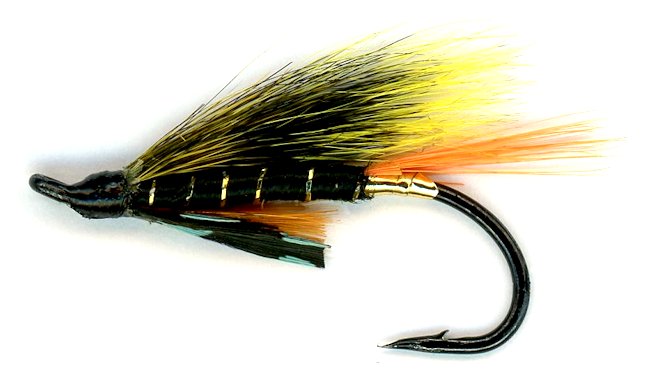The Munro Killer Salmon Single Hook Fly
The Munro Killer is in a strong position of winning the title best Scottish Salmon Fly. It is regarded as a good summer and late season pattern, but I have had good results in the spring.

SALMON AND STEELHEAD SINGLE HOOK FLY PATTERNS. Hook size 6 8 - $US each
The Munro Killer is a great fly which many would regard as indispensable. It is a modern variation on the traditional Thunder and Lightning used all over the world. Look for our Munro Killer Double Hook Salmon fly Munro Killer Treble Hook Salmon Fly and Munro Killer Salmon Alloy Tube fly. I have had great success with a Munro Killer when fishing for Salmon in Canada, Scotland and in Sweden. Bait fish have to move quickly in order to survive and your fly must do the same.
Ensure you maintain your retrieve until you feel your line stop Salmon do not slam into the fly like trout or bass usually do. With Coho especially you will sometimes see a wake following your fly. Although it is exciting and can be unnerving it is important that you keep the fly moving. Do not be tempted to slow up and let the Salmon catch up. This is unnatural behavior for a bait fish and may spook your target fish into rejecting your fly. I have found Dead-drifting around the edges of swirling eddies also brings takes with this fly.
HOW TO FISH RETURNING SALMON
The take of a returning salmon in freshwater on a fly such as the Munro Killer is different to that of a sea-trout or brown trout. Salmon have ceased to feed and have started their long fast to spawning time. Sometimes they attack with some violence because they are angered or frightened by the nearby presence of your artificial fly.
At other times, when they are not surprised by the sudden appearance of your fly, they rise and take slowly, deliberately, as though their juvenile salmon Parr memory has been awakened and they are satisfying their curiosity.
There are normally no fishing problems for the salmon fly fisherman to overcome in biggish pools. No special features in the way of ledges, boulders or holes to direct current which you find in the main stretch of most salmon rivers. A long cast can be made square across the river to reach the fish known to be lying on the far side.
A salmon sees the fly and turns to follow it down stream. It follows round with the fly and takes as the line straightens out. It may rise or take out of sight, depending on the time of the year, the water temperature and the depth at which the fly is fishing. It may just take the Munro Killer on its own whim of the moment.
Some salmon fly fishermen get thrown into indecision when the water flows too quickly for the fish to lie in midstream and they wait at the sides of the current in the slack. Fishing from the left bank for a salmon on your side of the fast flow, cast into the current, let the fly come round to drift into the slower flow and keep it there by mending the line.
Lengthen your next cast to put your Munro into the slacker water on the far side of the midstream flow. Mend line hard to keep your fly out of the fast water for as long as possible, with the fly hanging down the far side run.
Move down the pool and repeat the two casts until the flow spreads out and slows down. You can then make a long cast and let the fly come round in the usual way. Running fish often show and rest for a short time when they have ascended a rapid and moved into a tail pool. They stop just above the point at which the current speeds up as long as it goes downstream into the run. Cast a long line downstream on the far side of the tail of the pool and let the fly come across as slowly as possible.
CATCH & RELEASE ADVICE
The US Atlantic Salmon Federation gives the following information on best practice on how to release wild Atlantic and Pacific salmon. First use barbless or pinched books. Make sure you retrieve and release your fish quickly. Cut the leader if necessary. Remove the hook carefully. Keep the fish in the water, this is very important. Only allow five seconds out of water for taking a photo of your fish. Hold the fish gently in the natural swimming position facing upstream until it is revived, then release. If you follow these basic instructions, more fish will survive the trauma of being caught. That means there will be more fish in the river or lake to provide a good day's fishing in the future.
CUSTOMER'S COMMENT
The Brora is a fairly small but prolific salmon and sea trout stream just north of the Kyle of Sutherland, Scotland. It is really two rivers bulged in the middle by Loch Brora. The lower half is known as the Bottom River and the top half is called the Top River. In early season the bottom river fishes better first as the water temperatures increase. I find the Munro killer is a very productive fly for me at this time on a hook size 6 – 8 along with stoats tail and Ally’s Shrimp. - James Langridge


Salmon fishing books

